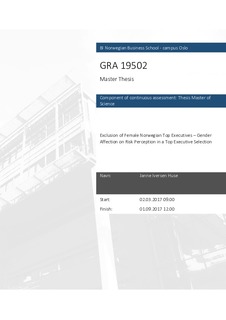| dc.description.abstract | While previous leadership literature has focused on the single relationship
between gender and employability of top executives, this thesis contributes by
exploring how the risk factors of men and women are unequally interpreted in the
evaluation process. With the use of an experimental design, four equivalent
résumés – two male and two female – were both rated and ranked by participants
of candidates’ employability. I predicted that women would be rated and ranked
lower than their male counterpart, and that the equivalent risk factor would be
evaluated differently between the genders. Findings from a sample of 107 top
executives and professional executive search agents from several of Norway’s
largest firms, as well as non-professionals, indicate that men and women have
unequal opportunities for being appointed in a top executive selection. The results
revealed that the predicted likelihood of being appointed as top executive was
more in favor of a male candidate. Even though female candidates were ranked
higher, implicit ratings revealed distinctive evidence as male candidates received
the highest ratings. Hence, implicitly favoring male candidates. This was
particularly true when participants were male. Moreover, further findings revealed
that employers were inconsistent with their evaluations when rating and ranking
candidates – showing tendencies of giving socially desirable responses. | nb_NO |

